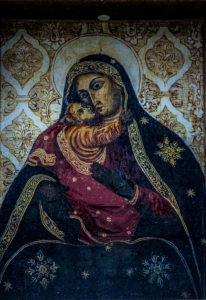This precious work was brought to Caltagirone by the noble Campochiaro family and donated to the Mother Church at the end of the 16th century.
The work consists of two painted sides, i.e. two icons or “cone“. During celebrations the work would be displayed showing the side of Christ, also called Dominus, hence the name Cona Domini. Whenever the city was struck by natural disasters or other evils, the side of the Virgin was shown so that worshippers could pray to her as they waited for a miracle. The masterpiece was so important and adored by the community that on 10 July 1644, she was declared patron saint of the city by public deed and was crowned with a golden crown on 31st May by Monsignor Luigi Bignami, the same day she is still celebrated today.
The masterpiece was so important and adored by the community that on 10 July 1644, she was declared patron saint of the city by public deed and was crowned with a golden crown on 31st May by Monsignor Luigi Bignami, the same day she is still celebrated today.
The Feast of the Madonna di Conadomini is celebrated in a particularly solemn way culminating in the offering of gifts from the earth following a large procession.
The procession is formed of farmers’ wagons and tractors decorated with rusedda, or bundles of cistus plant, accompanied by the sound of brogne, large seashells turned into sombre-sounding wind instruments.
Preceded by a banner called the triunfu with the sacred image of the Madonna di Conadomini, the procession climbs the 142 steps of the monumental and multicoloured Staircase of St. Mary of the Mountain, which is also coloured by the
infiorata
, as the city’s solemn and devout homage to its co-patron saint.